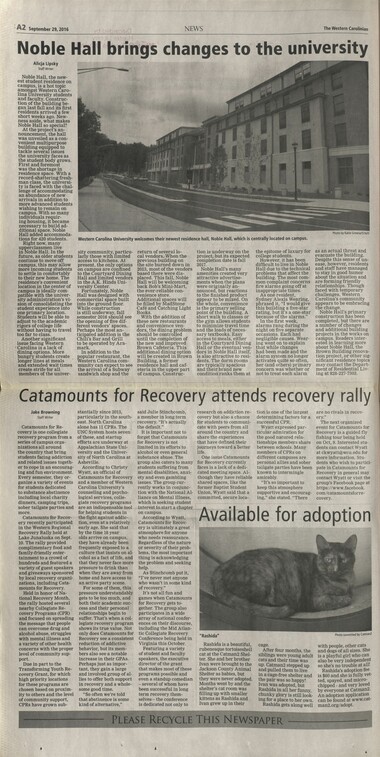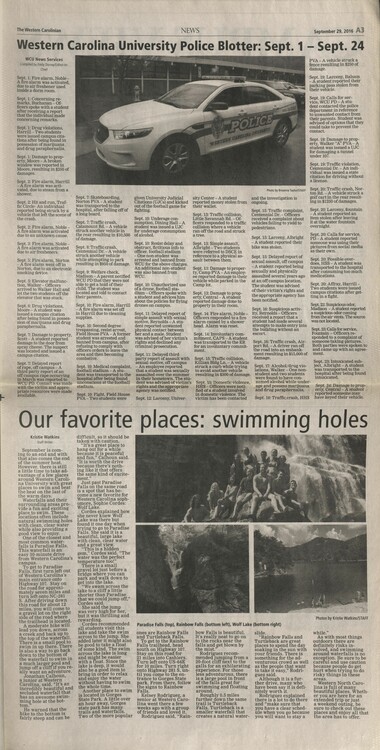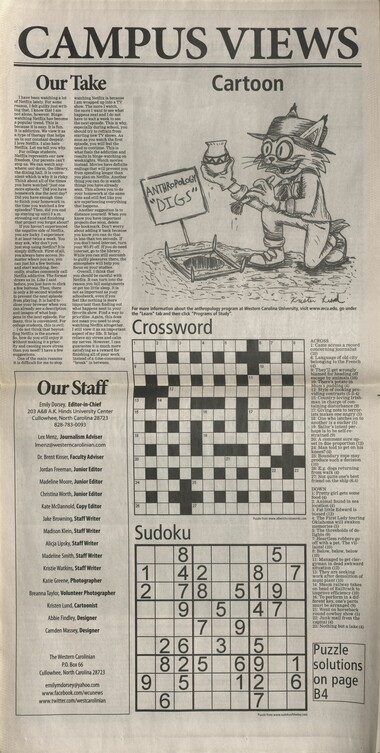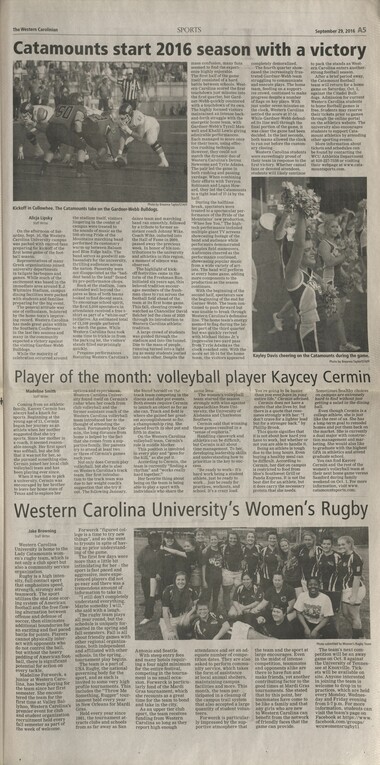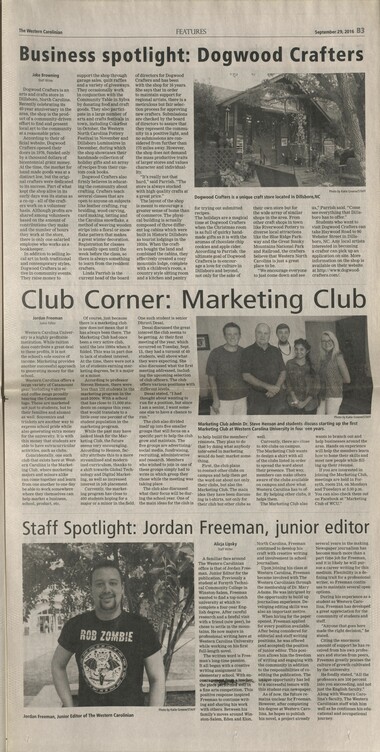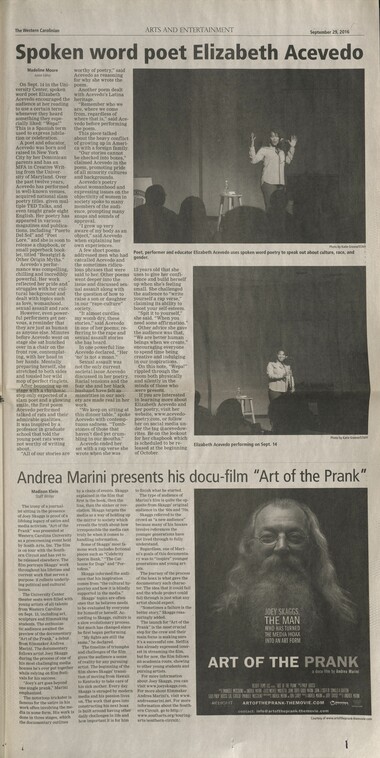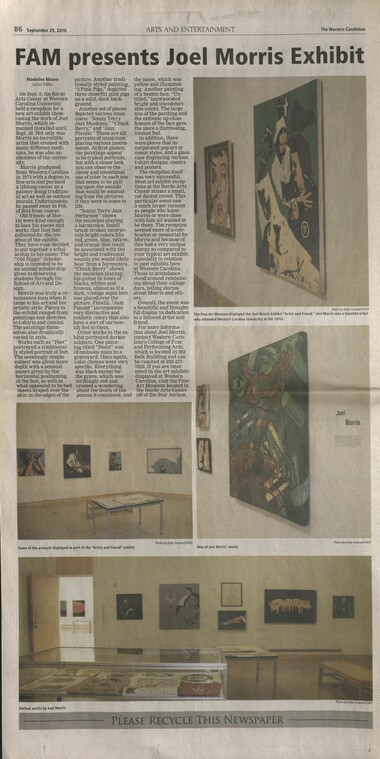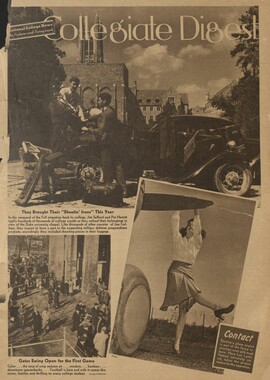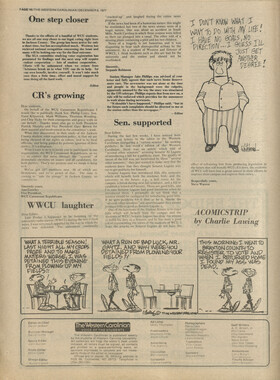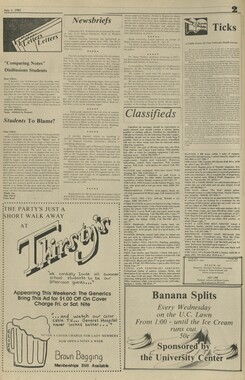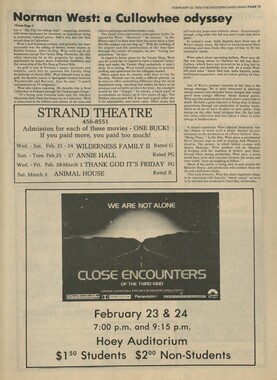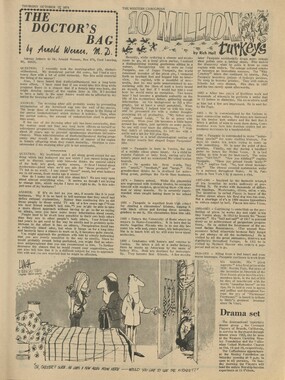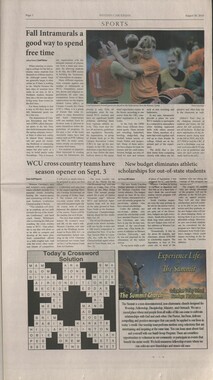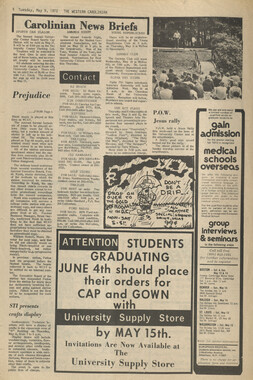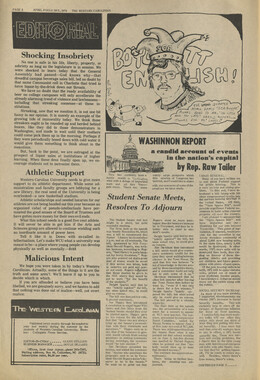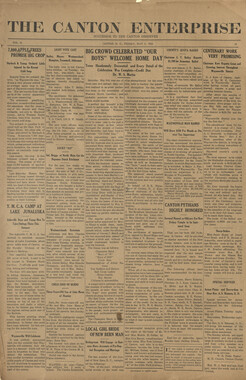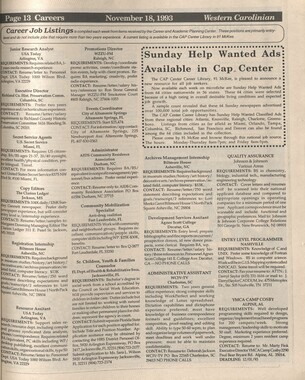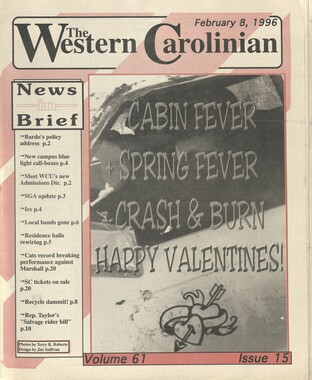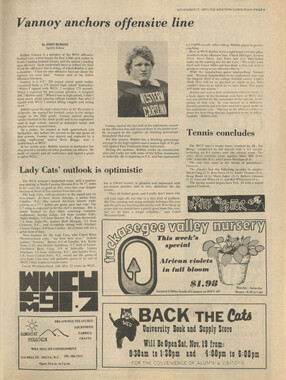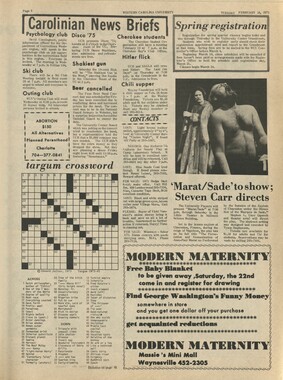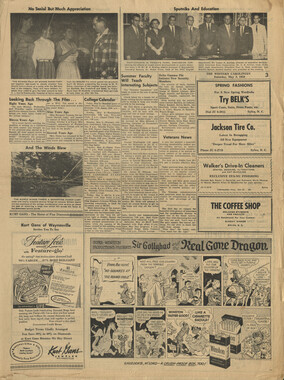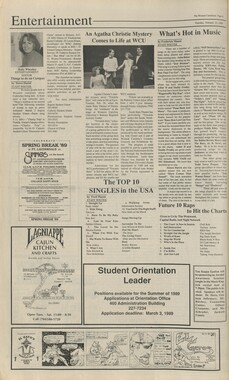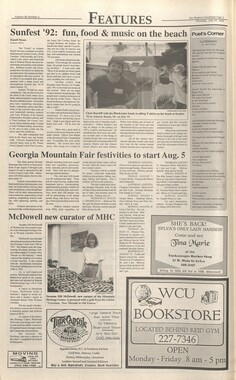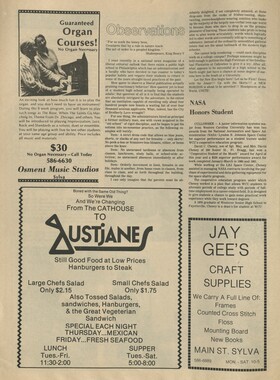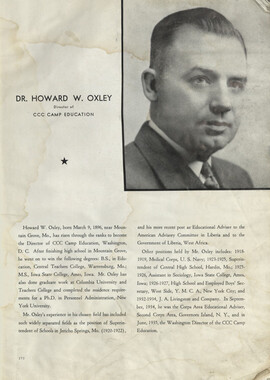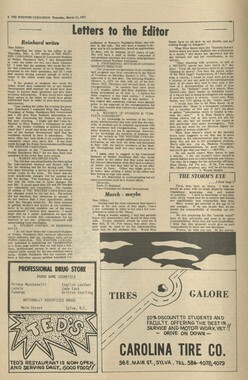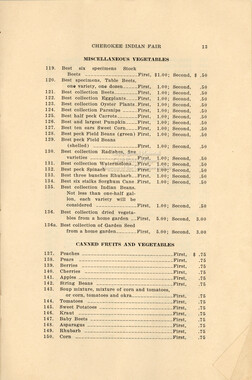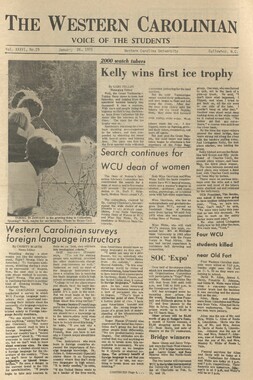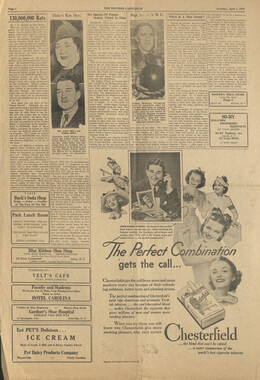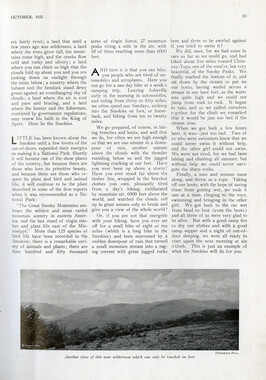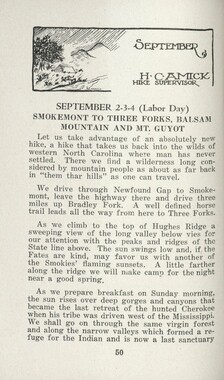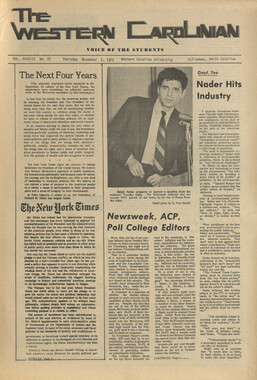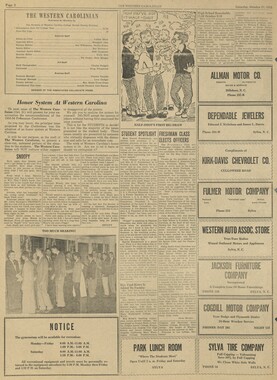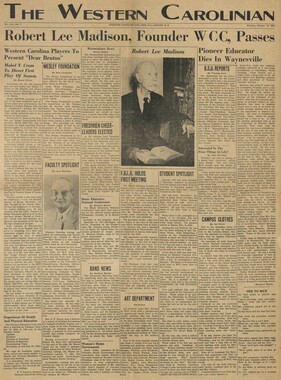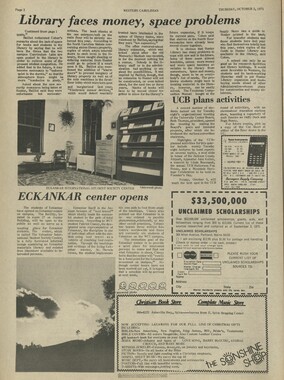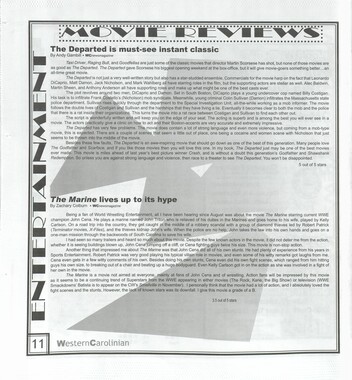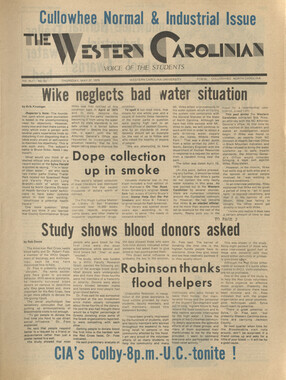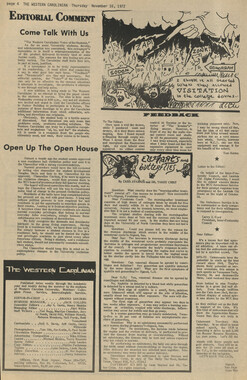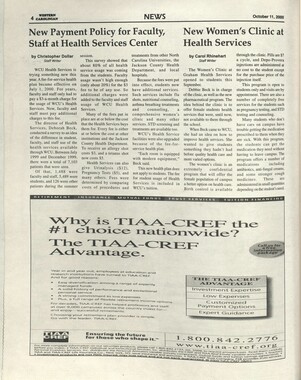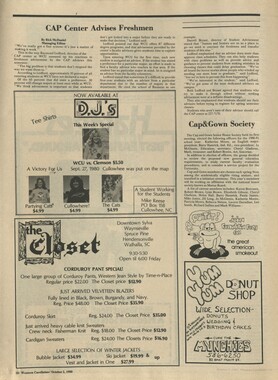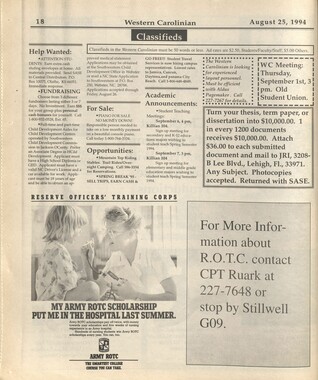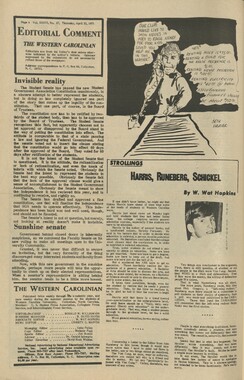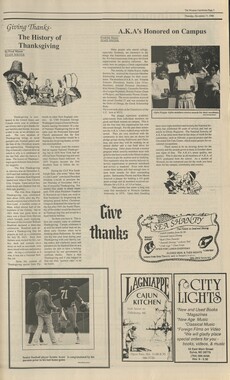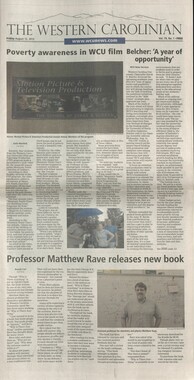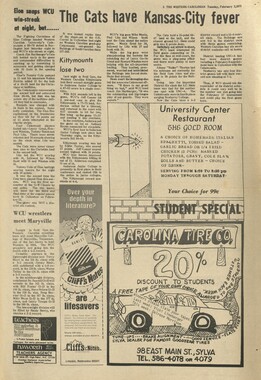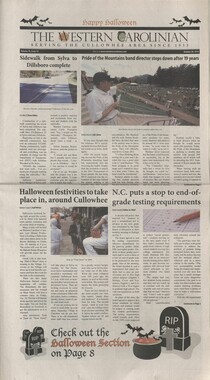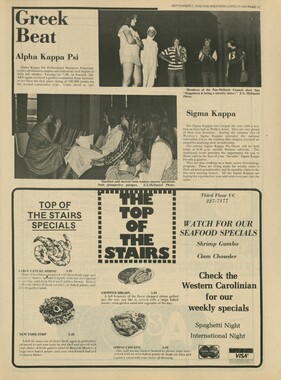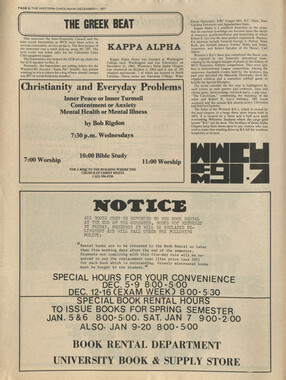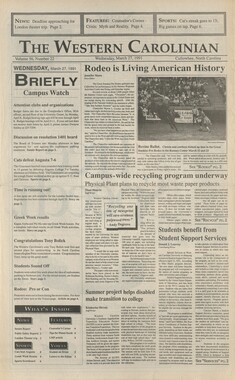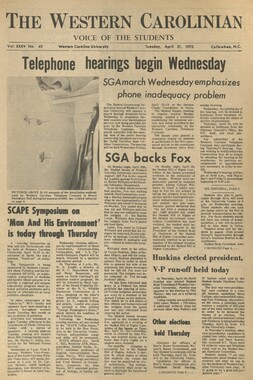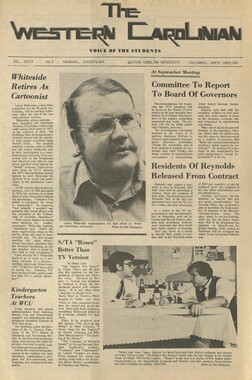Western Carolina University (21)
View all
- Canton Champion Fibre Company (2308)
- Cherokee Traditions (291)
- Civil War in Southern Appalachia (165)
- Craft Revival (1942)
- George Masa Collection (137)
- Great Smoky Mountains - A Park for America (3080)
- Highlights from Western Carolina University (422)
- Horace Kephart (973)
- Journeys Through Jackson (159)
- LGBTQIA+ Archive of Jackson County (89)
- Oral Histories of Western North Carolina (318)
- Picturing Appalachia (6617)
- Stories of Mountain Folk (413)
- Travel Western North Carolina (153)
- Western Carolina University Fine Art Museum Vitreograph Collection (129)
- Western Carolina University Herbarium (92)
- Western Carolina University: Making Memories (738)
- Western Carolina University Publications (2491)
- Western Carolina University Restricted Electronic Theses and Dissertations (146)
- Western North Carolina Regional Maps (71)
- World War II in Southern Appalachia (131)
University of North Carolina Asheville (6)
View all
- Allanstand Cottage Industries (62)
- Appalachian National Park Association (53)
- Bennett, Kelly, 1890-1974 (1463)
- Berry, Walter (76)
- Brasstown Carvers (40)
- Carver, George Washington, 1864?-1943 (26)
- Cathey, Joseph, 1803-1874 (1)
- Champion Fibre Company (233)
- Champion Paper and Fibre Company (297)
- Cherokee Indian Fair Association (16)
- Cherokee Language Program (22)
- Crowe, Amanda (40)
- Edmonston, Thomas Benton, 1842-1907 (7)
- Ensley, A. L. (Abraham Lincoln), 1865-1948 (275)
- Fromer, Irving Rhodes, 1913-1994 (70)
- George Butz (BFS 1907) (46)
- Goodrich, Frances Louisa (120)
- Grant, George Alexander, 1891-1964 (96)
- Heard, Marian Gladys (60)
- Kephart, Calvin, 1883-1969 (15)
- Kephart, Horace, 1862-1931 (313)
- Kephart, Laura, 1862-1954 (67)
- Laney, Gideon Thomas, 1889-1976 (439)
- Masa, George, 1881-1933 (61)
- McElhinney, William Julian, 1896-1953 (44)
- Niggli, Josephina, 1910-1983 (10)
- North Carolina Park Commission (105)
- Osborne, Kezia Stradley (9)
- Owens, Samuel Robert, 1918-1995 (11)
- Penland Weavers and Potters (36)
- Roberts, Vivienne (15)
- Roth, Albert, 1890-1974 (142)
- Schenck, Carl Alwin, 1868-1955 (1)
- Sherrill's Photography Studio (2565)
- Southern Highland Handicraft Guild (127)
- Southern Highlanders, Inc. (71)
- Stalcup, Jesse Bryson (46)
- Stearns, I. K. (213)
- Thompson, James Edward, 1880-1976 (226)
- United States. Indian Arts and Crafts Board (130)
- USFS (683)
- Vance, Zebulon Baird, 1830-1894 (1)
- Weaver, Zebulon, 1872-1948 (58)
- Western Carolina College (230)
- Western Carolina Teachers College (282)
- Western Carolina University (2008)
- Western Carolina University. Mountain Heritage Center (18)
- Whitman, Walt, 1819-1892 (10)
- Wilburn, Hiram Coleman, 1880-1967 (73)
- Williams, Isadora (3)
- Cain, Doreyl Ammons (0)
- Crittenden, Lorraine (0)
- Rhodes, Judy (0)
- Smith, Edward Clark (0)
- Appalachian Region, Southern (3032)
- Asheville (N.C.) (1945)
- Avery County (N.C.) (26)
- Blount County (Tenn.) (195)
- Buncombe County (N.C.) (1680)
- Cherokee County (N.C.) (283)
- Clay County (N.C.) (556)
- Graham County (N.C.) (238)
- Great Smoky Mountains National Park (N.C. and Tenn.) (535)
- Haywood County (N.C.) (3573)
- Henderson County (N.C.) (70)
- Jackson County (N.C.) (4925)
- Knox County (Tenn.) (35)
- Knoxville (Tenn.) (13)
- Lake Santeetlah (N.C.) (10)
- Macon County (N.C.) (421)
- Madison County (N.C.) (216)
- McDowell County (N.C.) (39)
- Mitchell County (N.C.) (135)
- Polk County (N.C.) (35)
- Qualla Boundary (982)
- Rutherford County (N.C.) (78)
- Swain County (N.C.) (2185)
- Transylvania County (N.C.) (270)
- Watauga County (N.C.) (12)
- Waynesville (N.C.) (86)
- Yancey County (N.C.) (72)
- Aerial Photographs (3)
- Aerial Views (60)
- Albums (books) (4)
- Articles (1)
- Artifacts (object Genre) (228)
- Bibliographies (1)
- Biography (general Genre) (2)
- Cards (information Artifacts) (38)
- Clippings (information Artifacts) (192)
- Copybooks (instructional Materials) (3)
- Crafts (art Genres) (622)
- Depictions (visual Works) (21)
- Design Drawings (1)
- Digital Moving Image Formats (2)
- Drawings (visual Works) (185)
- Envelopes (101)
- Exhibitions (events) (1)
- Facsimiles (reproductions) (1)
- Fiction (general Genre) (4)
- Financial Records (12)
- Fliers (printed Matter) (67)
- Glass Plate Negatives (381)
- Guidebooks (2)
- Internegatives (10)
- Interviews (823)
- Land Surveys (102)
- Letters (correspondence) (1045)
- Manuscripts (documents) (618)
- Maps (documents) (177)
- Memorandums (25)
- Minutes (administrative Records) (59)
- Negatives (photographs) (6090)
- Newsletters (1290)
- Newspapers (2)
- Notebooks (8)
- Occupation Currency (1)
- Paintings (visual Works) (1)
- Pen And Ink Drawings (1)
- Periodicals (194)
- Personal Narratives (10)
- Photographs (12977)
- Plans (maps) (1)
- Poetry (6)
- Portraits (4568)
- Postcards (329)
- Programs (documents) (181)
- Publications (documents) (2444)
- Questionnaires (65)
- Relief Prints (26)
- Sayings (literary Genre) (1)
- Scrapbooks (282)
- Sheet Music (2)
- Slides (photographs) (402)
- Songs (musical Compositions) (2)
- Sound Recordings (802)
- Specimens (92)
- Speeches (documents) (18)
- Tintypes (photographs) (8)
- Transcripts (329)
- Text Messages (0)
- A.L. Ensley Collection (275)
- Appalachian Industrial School Records (7)
- Appalachian National Park Association Records (336)
- Axley-Meroney Collection (2)
- Bayard Wootten Photograph Collection (20)
- Bethel Rural Community Organization Collection (7)
- Blumer Collection (5)
- C.W. Slagle Collection (20)
- Canton Area Historical Museum (2110)
- Carlos C. Campbell Collection (462)
- Cataloochee History Project (64)
- Cherokee Studies Collection (4)
- Daisy Dame Photograph Album (5)
- Daniel Boone VI Collection (1)
- Doris Ulmann Photograph Collection (112)
- Elizabeth H. Lasley Collection (1)
- Elizabeth Woolworth Szold Fleharty Collection (4)
- Frank Fry Collection (95)
- George Masa Collection (173)
- Gideon Laney Collection (452)
- Hazel Scarborough Collection (2)
- Hiram C. Wilburn Papers (28)
- Historic Photographs Collection (236)
- Horace Kephart Collection (861)
- Humbard Collection (33)
- Hunter and Weaver Families Collection (1)
- I. D. Blumenthal Collection (4)
- Isadora Williams Collection (4)
- Jesse Bryson Stalcup Collection (47)
- Jim Thompson Collection (224)
- John B. Battle Collection (7)
- John C. Campbell Folk School Records (80)
- John Parris Collection (6)
- Judaculla Rock project (2)
- Kelly Bennett Collection (1482)
- Love Family Papers (11)
- Major Wiley Parris Civil War Letters (3)
- Map Collection (12)
- McFee-Misemer Civil War Letters (34)
- Mountain Heritage Center Collection (4)
- Norburn - Robertson - Thomson Families Collection (44)
- Pauline Hood Collection (7)
- Pre-Guild Collection (2)
- Qualla Arts and Crafts Mutual Collection (12)
- R.A. Romanes Collection (681)
- Rosser H. Taylor Collection (1)
- Samuel Robert Owens Collection (94)
- Sara Madison Collection (144)
- Sherrill Studio Photo Collection (2558)
- Smoky Mountains Hiking Club Collection (616)
- Stories of Mountain Folk - Radio Programs (374)
- The Reporter, Western Carolina University (510)
- Venoy and Elizabeth Reed Collection (16)
- WCU Gender and Sexuality Oral History Project (36)
- WCU Mountain Heritage Center Oral Histories (25)
- WCU Oral History Collection - Mountain People, Mountain Lives (71)
- WCU Students Newspapers Collection (1923)
- Western North Carolina Tomorrow Black Oral History Project (69)
- William Williams Stringfield Collection (2)
- Zebulon Weaver Collection (109)
- African Americans (390)
- Appalachian Trail (35)
- Artisans (521)
- Cherokee art (84)
- Cherokee artists -- North Carolina (10)
- Cherokee language (21)
- Cherokee pottery (101)
- Cherokee women (208)
- Church buildings (190)
- Civilian Conservation Corps (U.S.) (111)
- College student newspapers and periodicals (2012)
- Dams (108)
- Dance (1023)
- Education (222)
- Floods (63)
- Folk music (1015)
- Forced removal, 1813-1903 (2)
- Forest conservation (220)
- Forests and forestry (1198)
- Gender nonconformity (4)
- Great Smoky Mountains National Park (N.C. and Tenn.) (181)
- Hunting (47)
- Landscape photography (25)
- Logging (122)
- Maps (83)
- Mines and mineral resources (9)
- North Carolina -- Maps (18)
- Paper industry (38)
- Postcards (255)
- Pottery (135)
- Railroad trains (72)
- Rural electrification -- North Carolina, Western (3)
- School integration -- Southern States (2)
- Segregation -- North Carolina, Western (5)
- Slavery (5)
- Sports (452)
- Storytelling (243)
- Waterfalls -- Great Smoky Mountains (N.C. and Tenn.) (66)
- Weaving -- Appalachian Region, Southern (280)
- Wood-carving -- Appalachian Region, Southern (328)
- World War, 1939-1945 (173)
Western Carolinian Volume 84 Number 01
Item
Item’s are ‘child’ level descriptions to ‘parent’ objects, (e.g. one page of a whole book).
-
-
A2 September 29, 2016 NEWS The Western Carolinian Noble Hall bri Alicja Lipsky Staff Writer Noble Hall, the new- est student residence on campus, is a hot topic amongst Western Caro- lina University students and faculty. Construc- tion of the building be- gan last fall and its first residents arrived a few short weeks ago. New- ness aside, what makes Noble Hall so special? At the projects an- nouncement, the hall was unveiled as a con- venient mateee? building equipped to tackle several issues the university faces as the student body grows. First and foremost was the shortage in residence space. With a record-shattering fresh- man class, the universi- ty is faced with the chal- lenge of accommodating an abundance of new arrivals in addition to more advanced students wishing to remain on campus. With so many individuals requir- ing housing, it became necessary to build ad- ditional space. Noble Hall added accommoda- tions for 420 students. Right now, many upperclassmen live in Noble Hall. In the future, as older students continue to move off campus, this may allow more incoming students to settle in comfortably to their new home. The residences convenient location in the center of campus is ideally com- patible with the univer- sity administrations vi- sion of consolidating the - student experience into one primary location. Students will be able to adjust to the academic rigors of college life without having to travel too far to class. Another significant issue facing Western Carolina is a lack of dining options. More hungry students create | longer lines at meals and extended wait times create strife for all members of the univer- ngs changes to the university Western Carolina University welcomes their newest residence hall, Noble Hall, which is centrally located on campus. sity community, particu- larly those with limited access to kitchens. At present, the only options on campus are confined to the Courtyard Dining Hall and limited vendors in the A.K. Hinds Uni- versity Center. Fortunately, Noble Hall was designed with commercial space built into the ground floor. While construction is still underway, fall semester 2016 should see the opening of five dif- ferent vendors spaces. Perhaps the most an- ticipated addition is the Chilis Bar and Grill to be operated by Ara- mark. In addition to the popular restaurant, the Western Carolina com- munity can expect to see the arrival of a Subway sandwich shop and the return of several lo- cal vendors.;When the previous building on the site burned down in 2013, most of the vendors based there were dis- placed. This fall, Noble Hall will be welcoming back Bobs Mini-Mart, the ever-reliable con- venience store. Additional spaces will be filled by MadStone Caf and Catching Light Books. With the addition of these new restaurants and convenience ven- dors, the dining problem should be controlled until the completion of the new and improved Brown Cafeteria. This additional dining option will be created in Brown Building, a former residence hall and caf- eteria in the upper part of campus. Construc- tion is underway on the project, but its expected completion date is fall 2017. Noble Halls many amenities created very attractive advertise- ments when the plans were originally an- nounced, but reactions to the finished product appear to be mixed. On the whole, convenience is the primary selling point of the building. A short walk to classes or the gym allows students to minimize travel time and the loads of neces- sary textbooks. Easy access to meals, either in the Courtyard Dining Hall or the eventual ven- dors in Noble Hall itself, is also attractive to resi- dents. The dorm rooms are typically spacious and their brand new condition ranks them at the epitome of luxury for college students. However, it has been difficult to live in Noble Hall due to the technical problems that affect the building. The most com- mon complaint concerns fire alarms going off at inappropriate times. As one resident, Sydney Alexis Wearing, phrased it, I would give this building a five-star rating, but its a one-star because of the alarms. In the first week, alarms rang during the night on five separate occasions. Each had negligible causes. Wear- ing went on to explain that while changes had been made and the alarm system no longer activates quite so often, her (and others) primary concern. was whether or not to treat each alarm Photo by Katie Greene/STAFF as an actual threat and evacuate the building. Despite this sense of un- ease, however, residents and staff have managed to stay in good humor about the situation and are forming friendly relationships. Though faced with temporary challenges, Western Carolinas community appears to be embracing the change. Noble Halls primary construction has been completed, but there are a number of changes and additional building projects in the works on campus. Readers inter- ested in learning more about Noble Hall, the Brown Building renova- tion project, or other sig- nificant residence topics may contact the Depart- ment of Residential Liv- ing at 828-227-7303. Recovery attends recovery rally Catamounts for Jake Browning Staff Writer Catamounts for Re- covery is one collegiate recovery program from a series of campus orga- nizations all around the country that bring students facing addiction and related issues togeth- er to cope in an encourag- ing and fun environment. Every semester, they or- ganize a variety of events for students dedicated to substance abstinence including local charity dinners, camping trips, sober tailgate parties and more. Catamounts for Recov- ery recently participated in the Western Regional Recovery Rally held at Lake Junaluska on Sept. 10. The rally provided complimentary food and family-friendly enter- tainment to a crowd of hundreds and featured a variety of guest speakers and giveaways sponsored by local recovery organi- zations, including Cata- mounts for Recovery. Held in honor of Na- tional Recovery Month, the rally hosted several nearby Collegiate Re- covery Programs (CPR) and focused on spreading the message that people can overcome drug and alcohol abuse, struggles with mental illness and a variety of other health concerns with the proper level of community sup- port. Due in part to the Transforming Youth Re- covery Grant, for which high priority locations for these programs are chosen based on proxim- ity to others and the level of community support, CPRs have grown sub- stantially since 2013, particularly in the south- east. North Carolina alone has 11 CPRs. The UNC System hosts seven of these, and startup efforts are underway at Appalachian State Uni- versity and the Univer- sity of North Carolina at Asheville. According to Christy Wyatt, an official of Catamounts for Recovery and a member of Western Carolina Universitys counseling and psycho- logical services, colle- giate recovery programs are an indispensable tool for helping students in the fight against addic- tion, even at a relatively early age. She said that by the time 18 year olds arrive on campus, they have already been frequently exposed to a culture that insists on al- cohol as a fact of life, and that they never face more pressure to drink than when they are away from home and have access to an active party scene. For some of them, this pressure understandably gets to be too much, and both their academic suc- cess and their personal relationships begin to suffer. Thats when a col- legiate recovery program shows its true value. Not only does Catamounts for Recovery see a consistent reduction of addictive behavior, but its mem- bers also see a notable increase in their GPAs. Perhaps just as impor- tant, they gain a large and involved group of al- lies to offer both support in recovery and a whole- some good time. So often were told that abstinence is some kind of alternative, said Julie Stinchcomb, a member in long term recovery. Its actually the default. It is important not to forget that Catamounts for Recovery is not limited in its efforts to alcohol or even general substance abuse. The group also caters to many students suffering from mental disabilities, anxi- ety and even gambling issues. The group cur- rently works in conjunc- tion with the National Al- liance on Mental Illness, which is seeking student interest to.start a chapter. Available for adoption on campus. According to Wyatt, Catamounts for Recov- ery is ultimately a great atmosphere for anyone who needs reassurance. Regardless of the nature or severity of their prob- lems, the most important thing is acknowledging the problem and seeking help. As Stinchcomb put it, Tve never met anyone who wasnt in some kind of recovery. Its not all fun and games when Catamounts for Recovery gets to- gether. The group also participates in a wide array of national confer- ences on their discourse, including the Mid Atlan- tic Collegiate Recovery Conference being held in Virginia this October. Featuring a variety of student and faculty speakers, the executive director of the grant that makes most of these programs possible and even a standup comedian ~ several of whom have been successful in long term recovery them- selves:- the conference is dedicated not only to research on addiction re- covery but also a chance for students to communi- cate with peers from all around the country and share the experiences that have defined their journeys toward a better life. One issue Catamounts for Recovery currently faces is a lack of a dedi- cated meeting space. Al- though they have reliable shared spaces, like the former Baptist Student Union, Wyatt said that a committed, secure loca- tion is one of the largest determining factors for a successful CPR. Wyatt expressed par- ticular admiration for the good natured rela- tionships members share between schools. Many members of CPRs on different campuses are personal allies and sober tailgate parties have been known to intermingle amicably. Tts so important to keep this atmosphere supportive and encourag- ing, she stated. There are no rivals in recov- ery. The next organized event for Catamounts for Recovery is a guided fly fishing tour being held on Oct, 9. Interested stu- dents can contact Wyatt at ckwyatt@wcu.edu for more information. Stu- dents who wish to partici- pate in Catamounts for Recovery in general may contact Wyatt or visit the groups Facebook page at https://www.facebook. com/catamountsforre- covery. Be | Rashida ' Rashida is a beautiful, rubenesque tortoiseshell : cat at the Catman2 Shel- : ter. She and her brother : Ivan were brought to the Jackson County Animal | Shelter as babies, but : they were never adopted. ' Months went by and the ' shelters cat room was : filling up with smaller : kittens as Rashida and : Ivan grew up in their cage. After four months, the siblings were young adult cats and their time was up. Catman2 stepped up and pulled them to live in a cage-free shelter and the pair was so happy! Ivan was adopted, but Rashida in all her funny, chunky glory is still look- ing for a place to her own. Rashida gets along well Photo sunmitted by Catman2 with people, other cats and dogs of all sizes. She is a playful girl who can also be very independent so shes no trouble at all! Rashidas adoption fee is $60 and she is fully vet- ted, spayed, and micro- chipped - and very love by everyone at Catman2. An adoption application can be found at www.cat- man2.org/adopt.
Object
Object’s are ‘parent’ level descriptions to ‘children’ items, (e.g. a book with pages).
-
The Western Carolinian is Western Carolina University's student-run newspaper. The paper was published as the Cullowhee Yodel from 1924 to 1931 before changing its name to The Western Carolinian in 1933.
-
